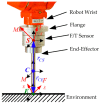Efficient Force Control Learning System for Industrial Robots Based on Variable Impedance Control
- PMID: 30081474
- PMCID: PMC6111768
- DOI: 10.3390/s18082539
Efficient Force Control Learning System for Industrial Robots Based on Variable Impedance Control
Abstract
Learning variable impedance control is a powerful method to improve the performance of force control. However, current methods typically require too many interactions to achieve good performance. Data-inefficiency has limited these methods to learn force-sensitive tasks in real systems. In order to improve the sampling efficiency and decrease the required interactions during the learning process, this paper develops a data-efficient learning variable impedance control method that enables the industrial robots automatically learn to control the contact force in the unstructured environment. To this end, a Gaussian process model is learned as a faithful proxy of the system, which is then used to predict long-term state evolution for internal simulation, allowing for efficient strategy updates. The effects of model bias are reduced effectively by incorporating model uncertainty into long-term planning. Then the impedance profiles are regulated online according to the learned humanlike impedance strategy. In this way, the flexibility and adaptivity of the system could be enhanced. Both simulated and experimental tests have been performed on an industrial manipulator to verify the performance of the proposed method.
Keywords: Gaussian processes; efficient learning; force control; industrial robot; variable impedance control.
Conflict of interest statement
The authors declare no conflict of interest.
Figures






















References
-
- Siciliano B., Sciavicco L., Villani L., Oriolo G. Robotics: Modelling, planning and control. Adv. Textb. Control Signal Process. 2009;4:76–82.
-
- Hogan N. Impedance control: An approach to manipulation: Part I—Theory. J. Dyn. Syst. Meas. Control. 1985;107:1–7. doi: 10.1115/1.3140702. - DOI
-
- Kieboom J.V.D., Ijspeert A.J. Exploiting natural dynamics in biped locomotion using variable impedance control; Proceedings of the 13th IEEE-RAS International Conference on Humanoid Robots; Atlanta, GA, USA. 15–17 October 2013; pp. 348–353. - DOI
-
- Buchli J., Stulp F., Theodorou E., Schaal S. Learning variable impedance control. Int. J. Robot. Res. 2011;30:820–833. doi: 10.1177/0278364911402527. - DOI
LinkOut - more resources
Full Text Sources
Other Literature Sources

